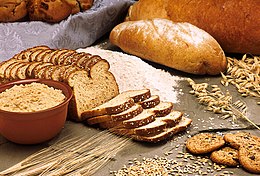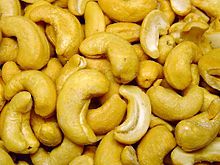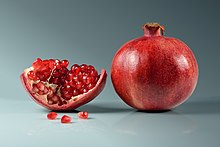This is an old revision of this page, as edited by Ortho (talk | contribs) at 23:05, 6 April 2022 (→Other: Osage orange). The present address (URL) is a permanent link to this revision, which may differ significantly from the current revision.
Revision as of 23:05, 6 April 2022 by Ortho (talk | contribs) (→Other: Osage orange)(diff) ← Previous revision | Latest revision (diff) | Newer revision → (diff)

An edible seed is a seed that is suitable for human or animal consumption. Of the six major plant parts, seeds are the dominant source of human calories and protein. A wide variety of plant species provide edible seeds; most are angiosperms, while a few are gymnosperms. As a global food source, the most important edible seeds by weight are cereals, followed by legumes, nuts, then spices.
Cereals (grain crops) and legumes (pulses) correspond with the botanical families Poaceae and Fabaceae, respectively, while nuts, pseudocereals, and other seeds form polyphylic groups based on their culinary roles.
Grains (cereals and millets)
Grains are the edible seed of a grass, a plant in the family Poaceae. Grains come in two varieties, the larger grains produced by drought-sensitive crops are called cereals, and the smaller drought-resistant varieties are millets. Grains can be consumed in a variety of ways, all of which require husking and cooking, including whole, rolled, puffed, or ground into flour. Many cereals are present or past staple foods, providing a large fraction of the calories in the places in which they are eaten. Today, cereals provide almost half of all calories consumed in the world.
| Cereals | |||||
|---|---|---|---|---|---|
| Family | Tribe | Genus | Species | Seed name(s) | Photo |
| Poaceae | Andropogoneae | Sorghum | S. bicolor | sorghum | |
| Zea | Z. mays | maize, corn, corn kernel | |||
| Eragrostideae | Eleusine | E. coracana | finger millet | ||
| Eragrostis | E. tef | teff | |||
| Oryzeae | Oryza | O. sativa | Asian rice | ||
| O. glaberrima | African rice | ||||
| Zizania | wild rice | ||||
| Paniceae | Digitaria | D. exilis | black fonio | ||
| D. iburua | white fonio | ||||
| Panicum | P. miliaceum | proso millet | |||
| P. sumatrense | little millet | ||||
| Pennisetum | P. glaucum | pearl millet | |||
| Setaria | S. italica | foxtail millet | |||
| Poeae | Avena | A. sativa | oat, oat groat | ||
| Triticeae | Hordeum | H. vulgare | barley, barley groat | ||
| Secale | S. cereale | rye, rye berry | |||
| × Triticosecale | triticale | ||||
| Triticum | T. aestivum | wheat, wheat berry | |||
| T. durum | durum, durum wheat | ||||
| T. monococcum | einkorn | ||||
| T. spelta | spelt, spelt wheat | ||||
| T. turanicum | kamut | ||||
| T. turgidum | emmer | ||||
| Thinopyrum | T. intermedium | Kernza | |||
Other grasses with edible seeds include:
- Astrebla pectinata – barley Mitchell grass
- Brachiaria piligera – wattle signalgrass
- Eragrostis eriopoda – woollybutt grass
- Panicum species, such as native millet (Panicum decompositum) and hairy panic (P. effusum)
- Themeda triandra – kangaroo grass
- Yakirra australiensis – bunch panic
Pseudocereals
A pseudocereal, or pseudocereal grain, is the edible seed of a pseudocereal, one of a polyphyletic group of plants that produce seeds that resemble those of cereals. Pseudocereals are used in many of the same ways as cereals.
| Pseudocereals | |||||
|---|---|---|---|---|---|
| Family | Genus | Species | Seed name(s) | Photo | |
| Amaranthaceae | Amaranthus | amaranth, amaranth grain | |||
| Chenopodium | C. berlandieri | pitseed goosefoot | |||
| C. pallidicaule | kañiwa | ||||
| C. quinoa | quinoa | ||||
| Capparaceae | Boscia | B. senegalensis | hanza | ||
| Lamiaceae | Salvia | S. hispanica | chia, chia seed | ||
| Linaceae | Linum | L. usitatissimum | flax, flaxseed, linseed | ||
| Moraceae | Brosimum | B. alicastrum | breadnut | ||
| Pedaliaceae | Sesamum | S. indicum | sesame, sesame seed | ||
| Polygonaceae | Fagopyrum | F. esculentum | buckwheat, buckwheat groat | ||
Legumes
See also: Category:Edible legumesA legume, or pulse, is the edible seed of a legume, a plant in the family Fabaceae. Legumes can be divided into grams, which do not split, and dals, which split.
| Legumes | |||||
|---|---|---|---|---|---|
| Family | Tribe | Genus | Species | Seed name(s) | Photo |
| Fabaceae | Dalbergieae | Arachis | A. hypogaea | peanut (groundnut) | |
| Cicereae | Cicer | C. arietinum | chickpea, garbanzo bean, gram | ||
| Fabeae | Pisum | P. sativum | pea | ||
| Millettieae | Millettia | M. pinnata | Indian beechnut | ||
| Phaseoleae | Cajanus | C. Cajan | pigeon pea | ||
| Glycine | G. max | soybean | |||
| Phaseolus | P. lunatus | lima bean | |||
| P. vulgaris | common bean | ||||
| Vigna | V. angularis | adzuki bean | |||
| V. mungo | black gram | ||||
| V. radiata | mung bean, green gram | ||||
| V. subterranea | Bambara groundnut | ||||
| V. unguiculata | cowpea | ||||
| Vicieae | Lens | L. culinaris | lentil | ||
| Vicia | V. faba | fava bean, broad bean | |||

Although some beans can be consumed raw, some need to be heated before consumption. In certain cultures, beans that need heating are initially prepared as a seed cake. Beans that need heating include:
- Acacia species (wattleseed), such as mulga (Acacia aneura), Halls Creek wattle (A. cowleana), southern ironwood (A. estrophiolata), umbrella bush (A. ligulata), Murray's wattle (A. murrayana), curara (A. tetragonophylla), witchetty bush (A. kempeana), wiry wattle (A. coriacea), mallee golden wattle (A. notabilis), ranji bush (A. pyrifolia), bardi bush (A. victoriae), coastal wattle (A. sophorae), shoestring acacia (A. stenophylla), and pindan wattle (A. tumida).
- Atriplex nummularia – old man saltbush
- Brachychiton species, such as kurrajong (Brachychiton populneus), northern kurrajong (B. diversifolius), desert kurrajong (B. gregorii), and red-flowered kurrajong (B. paradoxus).
- Bruguiera gymnorhiza – black mangrove
- Calandrinia balonensis – parakeelya
- Canarium australianum – mango bark
- Canavalia rosea – beach bean
- Entada phaseoloides – St. Thomas bean
- Eucalyptus species, such as tammin mallee (Eucalyptus leptopoda) and coolibah (E. microtheca)
- Marsilea drummondii – nardoo
- Portulaca species, such as common purslane (Portulaca oleracea) and large pigweed (P. intraterranea)
- Nymphaea gigantea – giant waterlily
- Rhyncharrhena linearis – purple pentatrope
Nuts
See also: Nut (food) and List of edible nuts



According to the botanical definition, nuts are a particular kind of fruit. Chestnuts, hazelnuts, and acorns are examples of nuts under this definition. In culinary terms, however, the term is used more broadly to include fruits that are not botanically qualified as nuts, but that have a similar appearance and culinary role. Examples of culinary nuts include almonds and cashews.
- Acorn
- Almond
- Beech
- Brazil nut
- Candlenut
- Cashew
- Chestnuts, including:
- Chilean hazel
- Egusi and other squash and melon seeds, including:
- Guinea peanut
- Hazelnuts, including:
- Hickory, including:
- Kola nut
- Macadamia
- Malabar almond
- Malabar chestnut
- Mamoncillo
- Mongongo
- Ogbono
- Paradise nut
- Pili
- Pistachio
- Shea nut
- Walnuts, including:
Nut-like gymnosperm seeds

Edible gymnosperm seeds that resembles nuts include:
Other

Other edible seeds that do not neatly fit into the above categories include:
- Cempedak
- Cocoa bean
- Coffee bean
- Durian
- Fox nut
- Hemp seed
- Jackfruit
- Lotus seed
- Mustard seed
- Osage orange seed
- Poppy seed
- Pomegranate seed
- Sunflower seed
- Pumpkin seed
- Watermelon seed
See also
- Eastern Agricultural Complex
- List of almond dishes
- List of dried foods
- List of food origins
- List of foods
- List of legume dishes
- List of maize dishes
- List of rice dishes
- List of vegetable oils
- List of seed-based snacks
- Oilseeds
Footnotes
- Variously referred to as a bean, berry, grain, groat, kernel, nut, or pulse, among other names, depending on the plant from which it derives.
- Seed, root, stem, leaf, flower, and fruit.
- Cultivars include the snap pea and snow pea (both fruits).
- Cultivars include the black bean, green bean (fruit), kidney bean, navy bean, and pinto bean.
References
- "Human Appropriation of the World's Food Supply". Global Change Curriculum. University of Michigan. 2006-01-04. Archived from the original on 2011-12-04.
- Desai, Babasaheb (2000). Handbook of Nutrition and Diet. CRC Press. p. 196.
- FAO. "ProdSTAT". FAOSTAT. Retrieved 2006-12-26.
- "Pulses and derived products". Definition and Classification of Commodities. Food and Agriculture Organization of the United Nations. 1994. Retrieved 2006-12-26.
- Isaacs, Jennifer. Bush food: Aboriginal food and herbal medicine.
- "Nut". Biology Online Dictionary. October 3, 2005. Retrieved 2006-12-26.
- "Nut". The Columbia Online Encyclopedia. 2003. Retrieved 2006-12-26.
- "Nuts and derived products". Definition and Classification of Commodities. Food and Agriculture Organization of the United Nations. 1996. Retrieved 2006-12-26.
Further reading
- Bailey, L.H., Bailey, E.Z. and Bailey Hortorium Staff (1976). Hortus Third. New York: Macmillan.
{{cite book}}: CS1 maint: multiple names: authors list (link) - Lewington, A. (1990). Plants for People. Cambridge, MA: Oxford University Press. ISBN 978-0-19-520840-5.














































